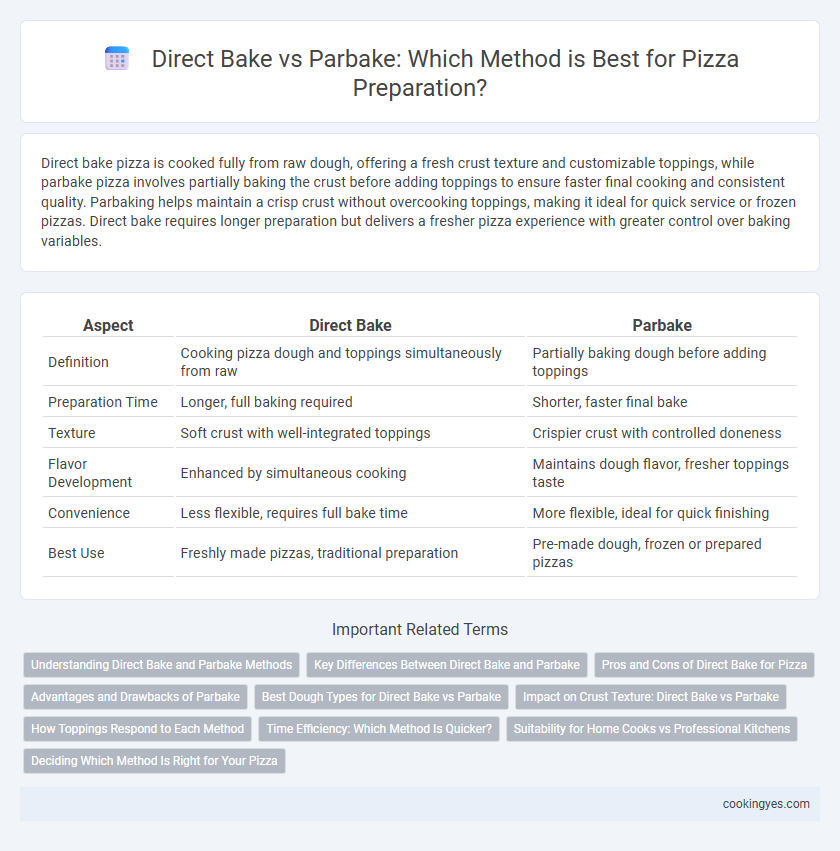Direct bake pizza is cooked fully from raw dough, offering a fresh crust texture and customizable toppings, while parbake pizza involves partially baking the crust before adding toppings to ensure faster final cooking and consistent quality. Parbaking helps maintain a crisp crust without overcooking toppings, making it ideal for quick service or frozen pizzas. Direct bake requires longer preparation but delivers a fresher pizza experience with greater control over baking variables.
Table of Comparison
| Aspect | Direct Bake | Parbake |
|---|---|---|
| Definition | Cooking pizza dough and toppings simultaneously from raw | Partially baking dough before adding toppings |
| Preparation Time | Longer, full baking required | Shorter, faster final bake |
| Texture | Soft crust with well-integrated toppings | Crispier crust with controlled doneness |
| Flavor Development | Enhanced by simultaneous cooking | Maintains dough flavor, fresher toppings taste |
| Convenience | Less flexible, requires full bake time | More flexible, ideal for quick finishing |
| Best Use | Freshly made pizzas, traditional preparation | Pre-made dough, frozen or prepared pizzas |
Understanding Direct Bake and Parbake Methods
Direct bake involves cooking the pizza dough and toppings together in a single process, resulting in a freshly baked crust with fully melted cheese and integrated flavors. Parbake refers to partially baking the pizza crust before adding toppings, allowing for a shorter final bake time and preventing sogginess, especially useful in frozen or take-and-bake pizzas. Understanding these methods helps optimize texture, flavor, and convenience based on specific pizza preparation needs.
Key Differences Between Direct Bake and Parbake
Direct bake pizza involves baking the dough and toppings together from raw, resulting in a fresher taste and a crispier crust. Parbake pizza features partially baking the crust before adding toppings, which reduces overall cooking time and prevents sogginess in the final product. Key differences include control over crust texture, preparation time, and flexibility in topping customization during the final bake.
Pros and Cons of Direct Bake for Pizza
Direct bake pizza offers a crispy crust and a freshly cooked flavor by baking the pizza from raw dough, which allows full control over baking time and temperature. However, it requires precise timing and can lead to uneven cooking if not monitored closely, increasing the risk of burnt edges or undercooked toppings. This method is ideal for artisanal pizza makers prioritizing texture and freshness but demands more skill compared to parbaking.
Advantages and Drawbacks of Parbake
Parbake pizza dough offers consistent cooking results by partially baking the crust before adding toppings, reducing final bake time and preventing sogginess. This method enhances convenience for restaurants and home cooks, allowing faster service and better temperature control. However, parbaked crusts may lack the depth of flavor and crispiness achievable with direct bake, and storage requirements can increase due to the need for refrigeration or freezing.
Best Dough Types for Direct Bake vs Parbake
For direct bake pizza preparation, high-protein bread flours or Caputo Tipo 00 flour provide excellent gluten development and a chewy texture that crisps nicely in a hot oven. Parbake pizzas benefit from doughs with moderate hydration and a balanced gluten structure, such as all-purpose flour blends, to ensure the crust does not become soggy during reheating. Whole wheat and multigrain doughs tend to perform better in parbake methods due to their density, which holds up well through multiple baking phases.
Impact on Crust Texture: Direct Bake vs Parbake
Direct bake results in a crispier, well-developed crust as the dough cooks thoroughly with toppings, promoting Maillard reaction and caramelization. Parbake, partially baking the crust before adding toppings, yields a softer, chewier texture that prevents sogginess by reducing moisture absorption. Choosing between direct bake and parbake influences the final pizza crust's crispness, chewiness, and overall mouthfeel, crucial for achieving desired quality in pizza preparation.
How Toppings Respond to Each Method
Direct bake pizza enhances toppings by allowing ingredients like cheese, vegetables, and meats to meld and caramelize under consistent heat, creating richer flavors and crisp textures. Parbake involves partially baking the crust before adding toppings, which helps prevent sogginess but may result in less integrated flavors as toppings undergo a shorter bake time. Toppings on direct bake pizzas typically develop more pronounced browning and moisture retention compared to the lighter, sometimes less cooked toppings on parbaked pizzas.
Time Efficiency: Which Method Is Quicker?
Direct bake pizza typically takes less time, around 10-15 minutes at high temperatures, since the raw dough cooks fully in the oven. Parbake involves pre-baking the crust partially, which adds an initial baking step but allows for faster final topping cooking, usually total time is longer when combined. For time efficiency, direct bake is quicker overall, especially when preparing fresh pizzas from scratch.
Suitability for Home Cooks vs Professional Kitchens
Direct bake pizza suits professional kitchens by delivering consistent results with high-temperature ovens that enhance crust texture and flavor. Parbake pizza is ideal for home cooks, offering convenience by partially cooking the crust to reduce total baking time and allowing for customizable toppings. The choice depends on kitchen equipment, time availability, and skill level, with direct bake favoring efficiency and parbake supporting simplicity.
Deciding Which Method Is Right for Your Pizza
Direct bake pizza provides a fully cooked crust with a crisp, golden texture that enhances the flavor of fresh toppings by baking them simultaneously. Parbake pizza involves partially cooking the crust before adding toppings, allowing for faster finishing and better control over topping doneness, ideal for thin or delicate ingredients. Choosing between direct bake and parbake depends on desired crust texture, topping moisture levels, and convenience during preparation.
Direct bake vs parbake for pizza preparation Infographic

 cookingyes.com
cookingyes.com